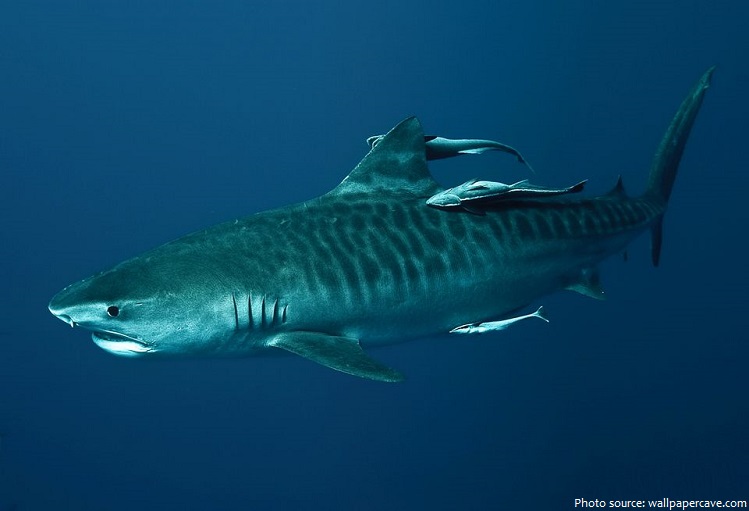The tiger shark (Galeocerdo cuvier) is the world’s most dangerous shark, after the great white.
Tiger sharks belong to one of the most popular shark families: the requiem sharks; and is the only extant member of the genus Galeocerdo.
They get their name from the dark stripes which resemble a tiger’s pattern seen mainly in juveniles. As these sharks mature, the lines begin to fade and almost disappear.
The tiger shark is often found close to the coast, mainly in tropical and subtropical waters throughout the world.
The tiger shark ranks in average size only behind the whale shark (Rhincodon typus), the basking shark (Cetorhinus maximus), and the great white shark (Carcharodon carcharias).
Tiger sharks are from 3.52 to 4.25 meters (10 ft 8 in to 13 ft 11 in) in length and weight between 385 and 635 kilograms (849 and 1400 pounds). The female is usually larger than the male.
One female specimen caught off Australia reportedly measured 5.5 m (18 ft 1 in) long and weighed an exceptional 1,524 kg (3,360 lb), although her weight is thought to have been bolstered by her pregnant state at the time.
Even larger specimens have been reported, but are considered as unconfirmed. Some papers have accepted a record of an exceptional 7.4 m (24 ft 3 in) length for a tiger shark, but since this is far larger than any scientifically observed specimen, verification would be needed.
Tiger sharks are strongly built sharks with two dorsal fins, a pair of pelvic fins, an anal fin, a caudal fin and five gill slits.
They use a type of camouflage called “countershading.” When seen from below, the shark’s white or light-yellow underbelly blends in with the sky. When seen from above, their dark back blends in with the murky depths. Topside, their skin color ranges from a bluish-green to dark gray or even black.
The tiger sharks head is somewhat wedge-shaped, which makes it easy for the shark to turn quickly to one side.
Tiger sharks have a strong sense of smell and sharp eyesight, making them excellent hunters.
Tiger sharks have big sharp teeth that can rip through nearly anything, including turtle shells. Their jaws house rows of 24 almost identical teeth that are shaped like circular saws, with curved cusps and finely serrated edges. The upper and lower teeth are similar in shape and size, and decrease in size from the front to the back of the mouth. Like most sharks, its teeth are continually replaced by rows of new teeth throughout the sharks life.
Tiger sharks have large eyes that can easily adapt to low light levels, allowing them to hunt at night and at depth. Tiger sharks also have the typical “Groundshark” feature of nictitating membranes (third eyelids), which roll down to protect their eyes when attacking.
They have small pits on the snout which hold electroreceptors called the ampullae of Lorenzini, which enable them to detect electric fields, including the weak electrical impulses generated by prey, which helps them to hunt.
Tiger sharks also have a sensory organ called a lateral line which extends on their flanks down most of the length of their sides. The primary role of this structure is to detect minute vibrations in the water. These adaptations allow the tiger shark to hunt in darkness and detect hidden prey.
The tiger shark is a solitary, mostly nocturnal hunter, and is notable for having the widest food spectrum of all sharks, consuming a variety of prey ranging from crustaceans, fish, seals, birds, squid, sea turtles, and sea snakes to dolphins and even other smaller sharks; you may only see a group of these sharks when there’s a large amount of food nearby.
They also have a reputation as a “garbage eater” and will devour almost everything that crosses their path — including inedible man-made objects that can often stay in their stomachs.
Odd items found in a tiger shark’s stomach include a chicken coop, a bag of money, a camera, boat cushions, a tom-tom drum, a tire, barrels, license plates, overcoats, boots, explosives, an entire horse head, a bulldog, a porcupine, hyenas, monkeys, deer antlers, a bag of potatoes…
Tiger sharks are among the largest predators in our oceans, yet their movements and migration patterns have largely remained a mystery. Some of the 24 sharks tracked using satellite tags travelled over 7,500 kilometers (4,660 miles) each year in a round trip to winter in the Caribbean’s coral reefs and spent the summer in the middle of the Atlantic Ocean, with some reaching as far north as Connecticut, US.
Certain tiger sharks have been recorded at depths of almost 900 meters (3,000 feet), but some sources claim they move into shallow water normally thought to be too shallow for a species of its size.
Mating in the Northern Hemisphere generally takes place between March and May and in the Southern Hemisphere, mating takes place in November, December, or early January.
The tiger shark is the only species in its family that is ovoviviparous; its eggs hatch internally and the young are born live when fully developed. The young develop inside the mother’s body up to 16 months. Litters range from 10 to 80 pups. A newborn is generally 51 to 76 cm (20 to 30 in) long.
The lifespan of the tiger shark is unknown.
While the tiger shark sits atop the food chain as an apex predator, killer whales have been known on rare occasion to prey on them.
The tiger shark is the species responsible for the second highest number of recorded shark attacks on humans, behind the great white shark.
Tiger sharks have a near completely undiscerning palate, and are not likely to swim away after biting a human, as great whites frequently do.
The World Conservation Union (IUCN) lists them as “Near Threatened,” meaning tiger sharks are likely to become endangered in the near future if fishing pressure continues.
They are heavily harvested for their fins, skin, and flesh, and their livers contain high levels of vitamin A, which is processed into vitamin oil.
In Hawaiian culture, the tiger shark is not only considered sacred, but legend has it that its eyeballs have special powers.
Legend suggests that the chiefs would acquire premonitions of future events by consuming the eyes of the tiger shark.
It’s said that the mother of the famous King Kamehameha (founder and first ruler of the Kingdom of Hawaii), asked for the eyes of the tiger shark during her pregnancy because they wanted to enhance the leadership qualities of the future king she carried.







